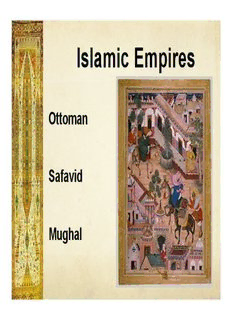
Islamic Empires - St. Francis Preparatory School PDF
Preview Islamic Empires - St. Francis Preparatory School
Islamic Empires Ottoman Safavid Mughal Age of Gunpowder Empires 1450 – 1800 Changed the balance of power This term applies to a number of states, all of which rapidly expanded during the late 15th and over the entire 16th century. Most significant were Portugal, Spain, the Ottoman Empire, the Safavid Empire, and the Mughal Empire but also included England, France, Tokugawa (Japan), Romanov Russia, and Ming/Manchu (Qing) China Varying degrees of impact new gunpowder weapons had some impact in most parts of the inhabited world, but each place reacted differently. In China & Japan, for example, guns were allowed minimal influence those countries kept themselves isolated, but then paid a high price, in the 19th century, by being vulnerable to the West. But while the West’s exploitation of gunpowder weapons enabled them to become wealthy & to dominate much of the globe, the effort cost countless lives & helped to keep Europe embroiled in war for much of modern history. Islamic Gunpowder Empires Islam contributed to the systems of legitimacy of the Ottomans, Safvids, and Mughals Simply, that was because most of the residents of the areas these governments ruled were Muslims, and they would accept no government as legitimate that was not Muslim. However, the steppe culture which all three of these ruling groups came from assisted them in every case in the project of bending Islam to fit state needs. The Islamic empires, 1500-1800 The Islamic Empires 1500-1800 Three Islamic Empires dominate from southern Europe to Northern India from 1500-1800 Ottoman Empire (Balkans, Middle East, North Africa, & Eastern Europe) Safavid Empire (Persia); Shia Islam Mughal Empire (Northern India)-had lasting Islamic cultural impact The Ottoman Empire • Turkic nomads enter Anatolia after Mongols • Mehmed II (r. 1451-1481) Expanded the Ottoman Empire into southern Europe Conquered Constantinople End of the Byzantine Empire - 1453 Becomes the capital of the Ottoman Empire Suleyman the Magnificent (1520-1566) Expanded the Ottoman Empire into the Middle East Moves further into Europe and besieged Vienna in 1529 Develops navy Ottoman Empire at the peak of its power The Ottoman Empire 1301-state founded by Osman (Ottoman) 1453 - fall of Constantinople to the Ottomans (Mehmed II the Conqueror) 1520-1566 - reign of Sulieman I the Magnificent 1529- first siege of Vienna 1571- Battle of Lepanto, first major defeat of the Ottomans by the Europeans 1683- second siege of Vienna 1699 - Treaty of C/Karlowitz, beginning of the end for the Ottomans - Austria, Poland, and Venice take major chunks of the Balkans from the Ottomans 1918-1924 - collapse of the Empire - political power then religious power (rise of the Young Turks) Ottoman Janissaries Troops raised by the Ottomans from Christian families in the Balkans, used as special shock troops and as palace guard, became most powerful force in the Ottoman Empire, massacred under the orders of Mahmud II in 1826 Janissaries were non-Muslim boys received by the sultan’s government in the devshirme – a kind of tax levied mostly on the Christian subjects of the empire who lived in the Balkans in Eastern Europe. They were slaves, but well paid for their services, well educated by the government, and given everything they had by the sultan from their earliest years. They were thus loyal only to the sultan, and so could defend him in the event that the aristocracy revolted. The janissaries were the only soldiers given gunpowder weapons.
Description: